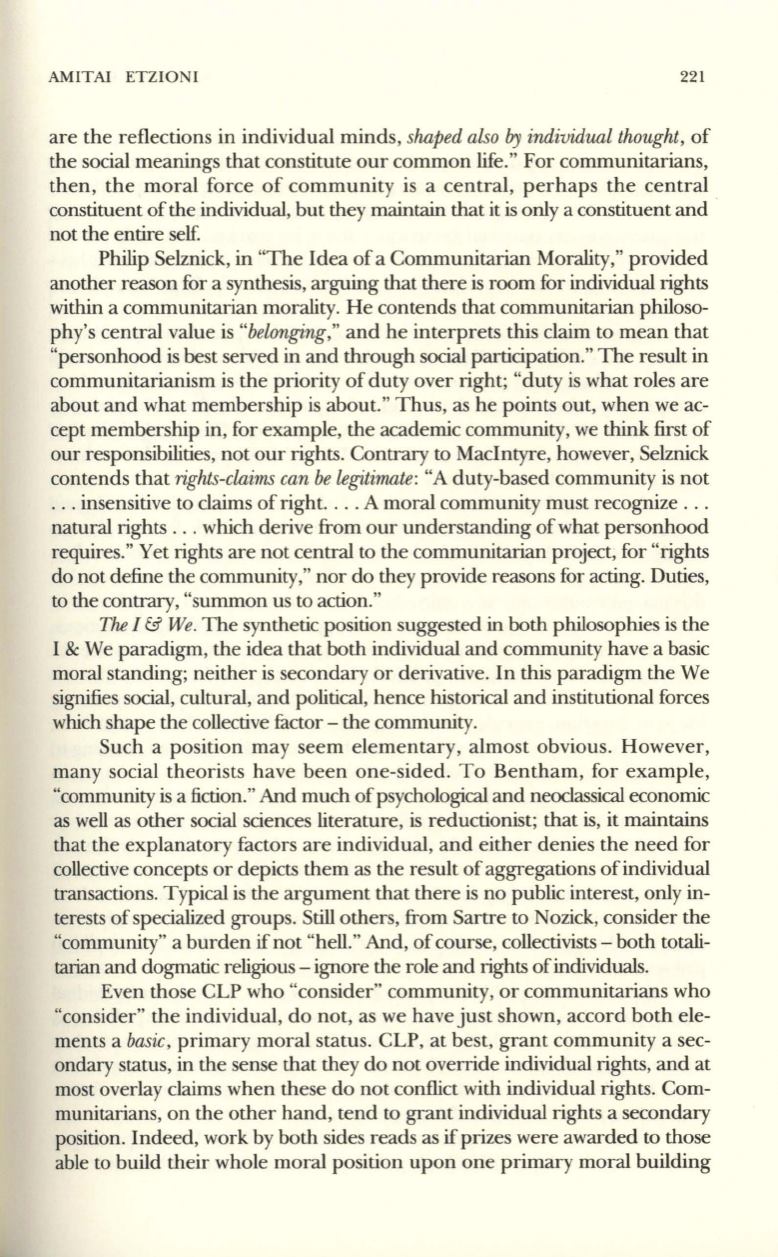
AMITAl ETZIONI
221
are the reflections in individual minds,
shaped also
by
individual thought,
of
the social meanings that constitute our common life." For communitarians,
then, the moral force of community is a central, perhaps the central
constituent of the individual, but they maintain that it is only a constituent and
not the entire se\£
Philip Selznick, in "The Idea of a Communitarian Morality," provided
another reason for a synthesis, arguing that there is room for individual rights
within a communitarian morality. He contends that communitarian philoso–
phy's central value is
"belonging,"
and he interprets this claim to mean that
"personhood is best served in and through social participation." The result in
communitarianism is the priority of duty over right; "duty is what roles are
about and what membership is about." Thus, as he points out, when we ac–
cept membership in, for example, the academic community, we think first of
our responsibilities, not our rights. Contrary to MacIntyre, however, Selznick
contends that
rights-claims can be legitimate:
"A duty-based community is not
... insensitive to claims of right. ... A moral community must recognize ...
natural rights ... which derive from our understanding ofwhat personhood
requires." Yet rights are not central to the communitarian project, for "rights
do not define the community," nor do they provide reasons for acting. Duties,
to the contrary, "summon us to action."
The I
&
We.
The synthetic position suggested in both philosophies is the
I &We paradigm, the idea that both individual and community have a basic
moral standing; neither is secondary or derivative. In this paradigm the We
signifies social, cultural, and political, hence historical and institutional forces
which shape the collective factor - the community.
Such a position may seem elementary, almost obvious. However,
many social theorists have been one-sided. To Bentham, for example,
"community is a fiction." And much of psychological and neoclassical economic
as well as other social sciences literature, is reductionist; that is, it maintains
that the explanatory factors are individual, and either denies the need for
collective concepts or depicts them as the result of aggregations of individual
transactions. Typical is the argument that there is no public interest, only in–
terests of specialized groups. Still others, from Sartre to Nozick, consider the
"community" a burden
if
not "hell." And, of course, collectivists - both totali–
tarian
and dogmatic religious - ignore the role and rights of individuals.
Even those CLP who "consider" community, or communitarians who
"consider" the individual, do not, as we have just shown, accord both ele–
ments a
basic,
primary moral status. CLP, at best, grant community a sec–
ondary status, in the sense that they do not override individual rights, and at
most overlay claims when these do not conflict with individual rights. Com–
munitarians, on the other hand, tend to grant individual rights a secondary
position. Indeed, work by both sides reads as
if
prizes were awarded to those
able to build their whole moral position upon one primary moral building


